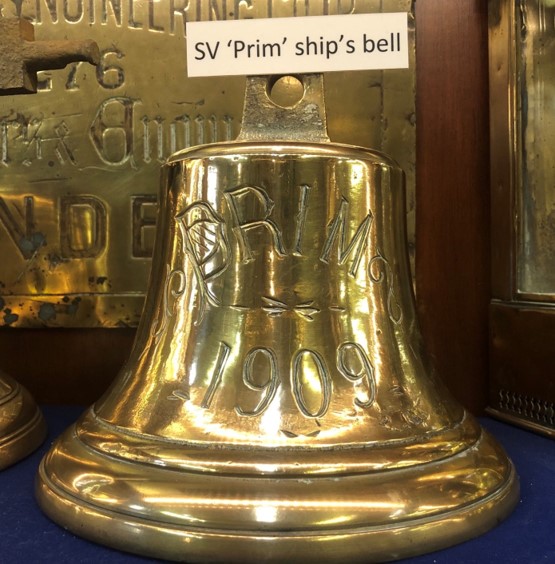The French schooner SV Prim was hardly three years old when it went off its route and wrecked at Atherfield on the Isle of Wight. The crew became disorientated in the fog and, sadly, the captain was killed in the accident. Volunteer Roger Burns relates on the tragic event.
Little is known about the three-masted wooden schooner Prim. It was launched in 1909 and owned by Husson from Sain-Brieuc, France. The ship was registed at Paimpon and estimated at 100 tons register. It carried about 200 tons of cargo of salt.
Prim was sailed by a six-man crew comprising Captain Pierre Quelilon, Pierre Henri who was the mate, Albert Minois, Raygeoud Gabriel, Celentin Guerrene, and Charles Marilles. They departed Lisbon en route for Boulogne and found themselves enveloped in fog for the entire voyage. Coming up the Channel, they had lost their bearings, going ashore in the dark at about 23.15 on Thursday, 22 February 1912 with a heavy sea running at the time. As the vessel struck, very close to the shore, a falling spar, or the boom, hit the captain on the head killing him instantly – the sea was washing over the vessel all night and the men lashed themselves to the bowsprit. In the early morning light and being so close to shore, the five men were able to scramble and swim ashore. They had been scantily dressed all night with no time to don more clothing, and found a route up the cliffs looming above them. That Friday morning, at about 06.30 am, they were noticed by Mr Snow, a fisherman living nearby at Sutton, as they were walking on the cliff top in a state of near collapse. He at once took them indoors beside his fire and gave them food and hot tea. Somewhat revived, all five were taken into the care of the Atherfield Coastguard. The Prim was wrecked with its timbers strewn along the beach (Figure 1).

Figure 1.A: SV Prim breaking up & 1.B: an enlarged section of Figure 1.A, illustrates the extent of the early devastation from the power of the sea, and by midday on that Friday, reports indicate that all of the upper works of the vessel had been carried away, and by that night, the sea had effectively smashed the schooner to pieces (Source: Image courtesy of Carisbrooke Castle Museum Trust)
During the Friday, the Captain’s body was recovered, and his head was found to have suffered severe damage. The Coastguard took good care of the five French sailors until the inquest the following day providing them with clothing by the Shipwrecked Mariner’s Society.
Only Pierre Henri, the mate, could speak a little English and at the inquest it transpired that the captain had been unable to see the lighthouse on high ground at St. Catherine’s Point due to the fog. The Coroner stated that it “seemed extraordinary that the vessel was not noticed from the shore until morning, and asked where were the coastguards? Chief Petty Officer Dawes stated that owing to a reduction in staff, the patrolling of the cliffs during the night had been discontinued, and the ship was not noticed until daylight. He had only four men, whereas there were formerly seven”, as reported in the Isle of Wight Times of 29 February 1912. The jury returned a verdict of “Accidental Death” and the sailors expressed their gratitude at the kindness from all concerned.
The French Consular agent based at Cowes, Mr. F.W.B. Faulkner, made arrangements for the sailors to be returned to France. It was agreed that the Captain would be buried on the Island, and on 27 February he was laid to rest at Brighstone where the Rector officiated and a wreath of arum lilies draped with the French National colours was laid. The ceremony was attended by the Coastguards and the Boy Scouts.
The ship’s bell (Figure 2) was recovered from the wreck and is on display at the Shipwreck Centre and Maritime Museum at Arreton Barnes, Isle of Wight. A ship’s bell bears an inscription with both the vessel’s name and launching year.
Atherfield on the south-west coast of the Isle of Wight has been the scene of many wrecks over the years. A selection of these wrecks includes SV Alcester, SV Auguste, SV Carn Brea Castle, and SV Dizzy Dunlop which are highlighted in blogs as shown.

